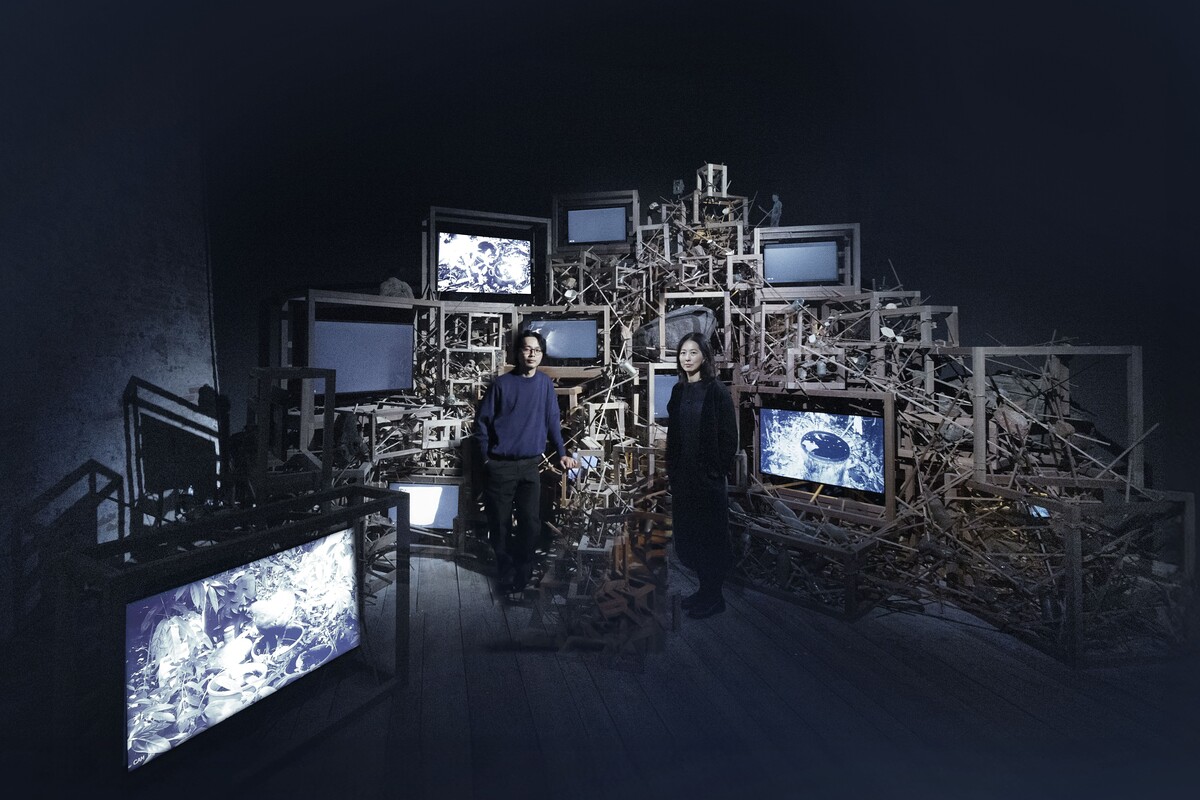Seeing Forest
April 20–November 24, 2024
Arsenale – Sale d’Armi
Campo della Tana 2169/F
30122 Venice
Italy
“Secondary forests are resilient and adaptable spaces for wildlife in Singapore…
They don’t discriminate against who belongs and who doesn’t.”[1]
With almost 9,000 people per square kilometre, Singapore is the second most densely populated nation in the world. Yet it is also home to thousands of different species of amphibians, birds, reptiles, mammals, and plants, with vegetation covering roughly half of its 735-square-kilometre landmass—and spontaneous, non-managed growth accounting for almost 30% of that.[2]
The artistic practice of Robert Zhao Renhui involves exploring these in-between spaces called secondary forests, thresholds between old-growth or primary forest and developed areas. Hundreds of hours of film and close to a decade of research have culminated in Seeing Forest. The exhibition, produced in collaboration with curator Haeju Kim and presented in the Pavilion of Singapore in Venice, invites us to consider a complex web of human and non-human co-existence.
As we enter the exhibition, we step into an uncharted forested zone where history and memory, humanity and nature, native and invasive intertwine. Moving between the human and more-than-human, invention and reality, Seeing Forest encourages a reflection on the ways in which urban design and human history can shape the natural world (and vice versa).
The central work of the exhibition, The Owl, The Travellers and The Cement Drain (2024) is a filmic essay that reveals a series of hypnotic scenes from the forest that are complemented by an unstable, fluctuating narrative of two human characters as they journey through it. By eschewing familiar documentary approaches, ecologically-minded activist perspectives, and the certainties of linear narrative, Zhao aims to transpose the forest into a new register: a mutable space of possibility.
In conversation with this film is Trash Stratum (2024), a sculptural video installation with screens arranged around a deconstructed cabinet of curiosities built from Nyatoh.[3] These reveal compelling scenes featuring various creatures that visit a makeshift watering hole in the form of an abandoned dustbin. Within this structure, objects from the forest can also be found, a poignant reminder of the presence of human histories so often entangled with those of nature. The dismantled wunderkammer references colonial systems of classification, destabilising natural history narratives in favour of more imaginative and fluid ways of drawing out relationships and networks.
Zhao’s practice has often included photography and its indexical quality, which is reflected in Buffy (2024), a digital print of a bird native to Southeast Asia, the buffy fish owl. In this image, the owl has its back turned to us, an evocative reference to the Heraclitan fragment, “nature loves to hide”, perhaps suggesting that concealment and discovery are somehow connected.
Complementing Stranieri Ovunque—Foreigners Everywhere, the theme of the 60th International Art Exhibition of the Venice Biennale, Seeing Forest offers a tribute to the undomesticated and free forests found along the margins of our urban lives, while exploring Singapore’s histories of settlement, colonisation, migration, and mutual co-existence amongst species.
Artist Robert Zhao Renhui said: “I have studied secondary forests for close to a decade and they yield constant discovery, surprise and meaning to me. They exist on the margins of the city, unwanted and overlooked, but they are the spaces where there is a sense of wildness, an equilibrium of forces resulting not from control but being allowed to just be. There is a rich intermingling of past and present, nature and culture, native and invasive, which makes these spaces radically hospitable and free.”
Commissioned by the National Arts Council (NAC), supported by the Ministry of Culture, Community and Youth and organised by Singapore Art Museum, Seeing Forest is presented in Venice from April 20 to November 24, 2024. After which it will return to Singapore, where it will be presented from January 2025 at SAM at Tanjong Pagar Distripark. A digital copy of the exhibition publication is available on www.seeingforest.com.
More information can be found in the press kit.
Media queries
International: Amanda Kelly and Alessandra Biscaro (Pickles PR)
Singapore and Southeast Asia: Leck Choon Ling (Tate Anzur) and Gwyneth Liew (SAM)
[1] From the essay, “Surprised by birds: A conversation between Robert Zhao and Yong Ding Li”, which is included in the catalogue that accompanies the exhibition.
[2] From the essay, “More Than Natural: Robert Zhao Renhui’s Ecosophy” by Jeffrey Kastner, which is included in the catalogue that accompanies the exhibition.
[3] Nyatoh is the collective trade name of several species of hardwood found in Southeast Asia rainforests.








